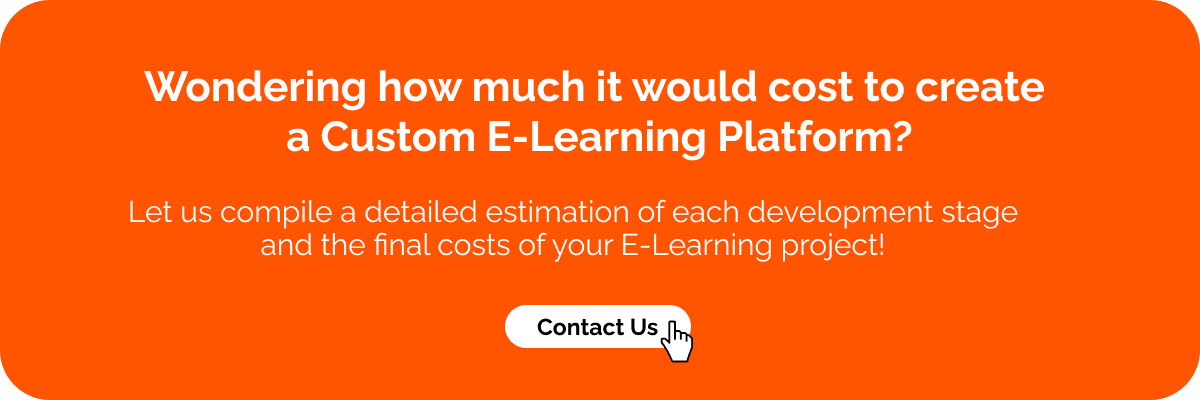Corporate e-learning is a newly sprung industry, yet it is becoming a powerful force changing the ways people learn. In this blog, we provide you with an overview of the top existing solutions for corporate e-learning and talk about key aspects to consider when starting elearning software development.
Corporate eLearning Frontier
The future of work has arrived, and its changing demands pose massive challenges to today’s workers. Because of the digital transformation impacting every industry, the hard skills sets needed for jobs are now constantly evolving. On top of that, soft skills, such as critical thinking, synthesis, and analytics are in increasing demand.
Disturbingly, though, these skills are exactly what traditional academia falls short of delivering. While most consumers are familiar with online e-learning models Coursera and Udemy have already made mainstream, the corporate sector needs something different. In a bid to match the workers’ level of literacy to the rising demands of the modern workplace, companies are harnessing e-learning to teach employees the skills they need, when they need them.
Corporate e-learning is truly a new frontier to be explored by businesses and developers of new educational tools and solutions. As the post-industrial society enters the age of lifelong learning, the role of corporate e-learning platforms will be decisive.

Stats & Predictions on Scale of B2B Online Course Market
Globally, the online market for e-learning solutions has already exceeded $250 billion and is expected to reach a staggering $1 trillion by 2027. The key drivers of its growth are:
- Increasing demands for e-learning in healthcare;
- The ongoing digitization of content;
- The rise of cloud-based LMS systems, which are easier to deploy and are more accessible.
The corporate segment of this vast global market is predicted to grow by $37.80 billion by 2025 and a steady CAGR of 13,14%, driven by the plummeting cost of employee training for organizations, and by the proliferation of smart devices making course content available everywhere.
The trends in corporate e-learning that are here to stay include:
The Demand for Instructional Content
Companies need courses that teach their employees practical skills, regardless of the industry and segment. The websites like Masterclass, tailored to the needs of particular organizations, and courses containing hands-on instructions that people could use in their jobs, from learning how to build a website to human genomic,
are in increasing demand.
The Demand for Engaging Learning
Interactivity, social media integration, and gamification are a must these days, as learners call for more fun and engaging learning content. The types of content also have to be diverse and include video and audio materials. The increasing number of course authoring solutions is now facilitating content creation, so we will definitely see the rise of platforms like Lynda.com for corporate learning.
E-Learning Platform Types
If you’re contemplating e-learning solutions development, you need to be aware of the existing types of e-learning platforms. The list below should set you on the right track.

Learning Management Systems (LMS)
LMS are websites for developing, hosting, and managing online courses, and much more. Today, top LMS software solutions are web-based and are packed with features for progress assessment, learning gamification, analytics, etc.
Online Training Platforms
Organizations willing to tap into learning website development, often start with online training platforms. Such platforms are industry and company-specific and are aimed at assessing the skills of job candidates or coaching company employees.
Massive Open Online Courses (MOOCs)
Coursera, Udemy, Udacity, and edX are now household names. These platforms are offering learning courses to everyone. Depending on the complexity, the courses may be free or fee-based. Learning web development, for example, will cost you more than a course on wellness and self-care.
Learning Experience Platform (LXP)
LXPs are platforms for customizable and personalized learning, which often use AI tools to bring users the type of learning tailored to their individual needs. In the B2B sector, platforms like Degreed help companies detect their employees’ knowledge gaps and assist them in employee upskilling and training. Edcast and Cornerstone are other examples of modern LXP platforms.
E-Learning Apps
E-learning apps are popular solutions for microlearning, making learning content accessible in a mobile format and available on the go. A segment of e-learning apps is also targeted at course authors, enabling them to easily create courses from scratch using their mobile phones. Apple Keynote is an example of a mobile presentation and course authoring app for iOS.
Custom E-Learning Platforms
Finally, there are custom e-learning platforms containing everything an organization needs to meet its needs in employee training. Custom software development is an excellent solution for enterprises that want immediate access to job skills exactly when necessary and in the exact format that matches their corporate culture and values.
In our next sections, we will explore the common features of such platforms as well as the examples of custom solutions for corporate e-learning.
Essential Features of eLearning Software Development
Building a customized digital platform for learning will involve carefully considering the unique requirements of your organization. The functional features your e-learning platform will ultimately have, will depend on the specifics of your company and its learning needs. Still, if you want to create an e-learning platform that ensures efficient personnel training, some features are absolute must-haves.

The MVP features educational platforms must include are:
- User profile and authentication
Users should be able to register their accounts on the platform and edit their profiles.
- Course pages
Creating online courses will involve setting up course pages containing all the details: description, materials, information about the teacher, and even the gamification elements.
- Dashboards
Both students and teachers should be able to access dashboards with course details: number of hours, progress and attendance reports, etc.
- Course-building tools
Your corporate platform should include a set of convenient course authoring tools, enabling you to create and broadcast your own unique course content in different models.
- Communication tools
Teachers and students should be able to communicate, comment on what they’ve learned, and share knowledge and impressions. Interactivity and peer-to-peer communication will build successful learning and yield impressive results.
- The admin panel
To create a learning website, you need an admin panel that will include website administration tools, tools for course evaluation and approval, reporting tools, admin dashboards, etc.
There are also some essential non-functional requirements, such as:
- Accessibility
Employees should be able to access your e-learning platforms through their mobile devices. Your platform should also run on both iOS and Android.
- UI/UX
A top-notch user experience and a convenient interface will make online learning enjoyable, boost employee engagement, and bring better learning outcomes.
- Integration with other systems
Your e-learning platform should integrate with the financial, HR, and product databases of your company.
- Scalability
It’s always best to plan for an increasing amount of learners and courses in advance, to avoid bottlenecks and downtime in the future. Make sure your system has all the necessary infrastructure resources to be able to scale on-demand and ensure excellent performance.
Benefits & Challenges of eLearning Software Development
Corporations are in dire need of skilled workers, and workers seek opportunities for continuous vocational training to stay competitive.

Benefits of Corporate E-Learning Platforms
While this may seem obvious, let’s take a closer look at the benefits of e-learning for business.
- Accessibility
Learners are no longer tied to physical classrooms – they can access educational content anytime and anywhere.
Read also: How to Make an Interactive VR Whiteboard for Meetings
See how to collaborate efficiently while working remotely
- Cost-efficiency
E-learning is much cheaper than traditional brick-and-mortar education and unhampered by the need to rent premises, pay professors’ wages, and provide catering and course materials.
- Saving time
Corporate e-learning can be easily delivered at the exact moment they need for a particular skill to emerge.
- Employee retention
Employees are more willing to stay loyal to employers that provide them with opportunities for learning and gaining new skills.
- Competitive edge
Almost 70% of Fortune 1000 companies report a lack of skilled workers to act as a major obstacle to success. Eliminating this roadblock by building an online education platform gives an organization a distinct competitive advantage.
Read also: An Innovative Strategy to Improve Learning Efficiency
See how to better combine the learning process with technologies
However, a lot of organizations struggle with e-learning adoption.
Challenges of Corporate E-Learning Platforms
The barriers to implementing e-learning management systems for workers include:
- Technical issues
Integrating e-learning platforms with legacy organizational infrastructures and software is one of the major challenges to online e-learning adoption in large enterprises and SME companies.
- Irrelevant course content
Despite the plethora of various e-learning platform types, the content of courses often has no direct relevance to the needs of a particular company. The solution lies in creating online courses by organizations’ experts and in developing unique course content based on internal expertise.
- Lack of course building expertise
Successful e-learning platform development may be hampered by a lack of course-building expertise. Organizations also have to plan for the extra time and resources needed to build a custom online education platform.
- Employee resistance to change
People tend to resist changes, and implementing e-learning in a B2B sector may be difficult because of the lack of acceptance. Another issue is motivation – people accustomed to traditional classroom learning may find it difficult to initiate studying by themselves.
- Lack of human interaction
People who study online often feel deprived of human interactions. They find existing e-learning models too formal and lacking a “human touch”.
Yet, the corporate sector is still finding means of overcoming these challenges, such as:
- Fostering internal expertise;
- Building social e-learning platforms to encourage employees to learn from each other;
- Using gamification techniques and adding interactivity and discussions, etc.
Yet, as challenging as the adoption of e-learning may be, we are witnessing an unprecedented demand for e-learning app development and online education platform development.
Best Examples of eLearning Software Development
In one of the previous sections, we have listed the most common education platforms types. Below are examples of successful market players that are currently using custom-build edtech platforms.

Most of the companies listed below are using 3D simulations to ensure effective immersive learning. We have chosen the automotive sector players to demonstrate how enterprises with complex production cycles can successfully leverage digital learning capabilities.
Volvo
Volvo runs a Volvo eLearning online portal granting its 50,000 employees access to online learning content anytime anywhere. It’s also one of the pioneers in using 3D simulation for training. The company uses Gomo course authoring tools and obviously knows how to build a great course authoring strategy for the automotive industry.
Honda
Honda has been using edtech to bring knowledge via Honda E-Learning to its 40,000 employees based in different countries for more than a decade. The company has started off by creating a centralized knowledge repository for its employees and ensuring that everyone could learn within working hours. It has been continuously proving its dedication to educating workers about manufacturing.
In 2015, the company created a manufacturing video-game build to increase awareness about manufacturing careers in the automotive sector.
Renault
Renault is one of the companies, dedicated to not only coaching its workers but also to bringing training services to over 80 firms in the automotive industry. The e-learning portal or the Renault Business Academy features courses on IT, Manufacturing, Leadership, Digital Transformation, Risk Management, Finance, and more. The company has been using 3D simulators for over 7 years now, helping its designers and engineers build better products.
Tesla
The leading player in the market of electric cars, Tesla also aims to dominate the e-learning scene. Its e-learning programs target not only existing employees but also students considering careers at Tesla and Tesla job applicants. For the automotive industry training, the company uses a blended approach of in-class study, hands-on training, and self-paced learning. The company places emphasis on using microlearning to integrate training into everyday work experiences.
Nissan
Nissan is one of the companies that value lifelong learning and do all it takes to bring this concept to life. The company uses a combination of learning approaches in its Nissan Global Training Center (GTC) – from classroom-style instructions to online learning via the Nissan Academy portal. The company uses visualization techniques to teach practical skills to its employees.
Volkswagen
One of the brands with its own robust learning center, Volkswagen Group, combines learning via an e-learning portal with other types of employee training. The company uses online courses to replace in-person instructions and has already developed over 30 simulation courses for employees. Volkswagen is also one of the companies pioneering the use of VR in the automotive industry. Its training center called Volkswagen Digital Reality Hub features versatile knowledge bases, meeting rooms, and training programs.
BMW
BMW Group is also one of the companies using an e-learning platform called BMW Group Knowledge Enabling Platform to meet the learning needs of its employees across the globe. It is also one of the earliest adopters of immersive technologies and has been integrating them into its workflows since the 90s. BMW is implementing a training system based on virtual reality to train employees in areas like HR, customer service, and assembly line operations. The company also creates virtual representations of its car models using Unreal Engine 4.
Other key players on the automotive scene, including Toyota, Jaguar, Audi, Ford, and Mercedes-Benz are also reaping the benefits of online learning and using 3D simulations to provide their employees with practical, just-in-time job skills. With the proliferation of immersive technologies and broadband Internet, we can also predict this trend to be successfully adopted by market players outside the automotive sector.
The Impressive Value of 3D Simulations in Learning Platforms Development
If you’re thinking about how to create an online learning platform for your company, you want to keep abreast of the latest trends in learning technology. A growing trend gaining increased popularity in corporate training is 3D simulation. Corporate educators are now teaching practical skills to employees using immersive experiences.
Simulation-based learning has proved highly effective in industries like:
- Healthcare
- Mining
- Manufacturing
- Construction
- Defense and any other business domains require practical hands-on skills.
Using 3D simulation and interactive apps in corporate e-learning has a range of tangible benefits:
- It is completely risk-free
- It ensures knowledge retention
- It helps users learn from real-life experiences
- It saves costs and brings quick results
- It provides the possibility for instant evaluation and assessment
These obvious advantages make simulation learning highly attractive for companies, and are surely worth considering if you want to create your own e-learning website.
Let’s now take a closer look at the security aspects of learning management systems.
Security Aspects of Learning Management Development
A corporate e-learning platform containing a plethora of employee personal data, unique content, and company expert knowledge is an attractive target for cybercriminals. Hence, e-learning security should by no means be overlooked, if you plan on building an ed-tech solution. The corporate e-learning platform security aspects include:
- Authenticity: ensuring that the system is available to authorized users only.
- Access control: making sure that no intruders access the platform’s learning course content and users’ profiles.
- Confidentiality: preventing information leakage and disclosure of users’ personal data.
- Integrity: preventing third parties from tampering with the platforms, or data from being corrupted through technical disruptions.
- Availability: granting users non-disrupted access to the portal and its services.
- Non-repudiation: making sure that the validity of certain actions and data cannot be questioned. For example, if a user sends a message, he or she should not be able to deny the responsibility for sending it.
These aspects call for a reliable security protection system, which should include:
- Strong authentication and verification features;
- AI tools for detecting unknown threats and suspicious activity in real-time;
- Encryption techniques to ensure secure communication between the platform users.
- Distributed firewall protection with access rights control capabilities.
It’s also a good idea to impose security policies controlling who, when, and under what circumstances has the right to move, copy or change the course content and learning assets. The growing trend also lies in using biometric authentication to protect users’ profiles from hijacks and identity theft.
5 Tips to Get the Most Value Out of eLearning Software Development
Making your e-learning initiative work will require some preparation and a carefully planned implementation strategy.

Below are some useful tips that will help you get the most value out of your e-learning project.
#1. Define Your Goals
Align your e-learning strategy to your key company goals. For example, if the fulfillment of nearest company goals requires advanced marketing & sales training, focus on building the corresponding courses first.
#2. Decide on the Best LMS Platform
You don’t necessarily need to use top LMS software packed with features you will rarely use. If you’re having difficulties choosing the right system, contact companies offering free LMS consulting services.
Yet, the best e-learning platforms are custom-made. The automotive companies using custom-built LMS are illustrative examples of how enterprises with complex processes are successfully leveraging tailored edtech systems built to meet their unique employee training and education needs.
If you plan to develop a custom LMS, choose a reliable contractor who knows how to build an online learning platform. Reliability and proven expertise are a must; also, make sure your tech partner provides consistent support for the platform users when they need it.
#3. Foster Internal
Learn how to create an e-learning course or assign a person who will be responsible for course creation and content. Collaborate with experts within your company to build courses based on your unique expertise.
#4. Run a Pilot
The cost of e-learning initiatives for enterprises is quite high, so before you start implementing a full-scaled learning platform it’s best to run a pilot project to see how it goes. Don’t forget to collect metrics and evaluate its success.
If you want to see how an e-learning system will propel your corporate education efforts without getting into heavy expenses, building an MVP might be the best choice. Testing an MVP for a proof of concept will give you many insights and enable you to make the necessary adjustments.
#5. Communicate the Value of E-learning to Your Employees
Treat employee resistance to change as something normal, but do communicate the value of new learning initiatives. Assign a Learning Coordinator to help employees adjust to a new learning model and get used to new training tools.
How Much Does It Cost to Create a Custom Learning Management System?
If you have your mindset on building your own learning platform, create a budget for your e-learning software development needs.
Your expenses will largely depend on the complexity of your solution, so think carefully about your learning priorities and goals before you talk to software developers. If you need to build a learning website with basic features, your software development costs are likely to be considerably lower than the cost of building a powerful learning management platform supporting a wide range of content formats, and integrations.
Read more: How to Save Money on a Web Project for Businesses
Learn how to select the best tech stack for your web application
The technologies that you will implement will also have a decisive impact on the e-learning development costs.
While the web development costs of a simplistic web learning platform may vary within the range of $15,000 – $25,000, the costs of such a web learning solution with integrated technologies like AR/VR will range from $25,000 to $35,000.
How Visartech Can Help to Develop eLearning Software?
At Visartech we know how to create an e-learning website for your corporate learning needs. We also have proven experience in building complex interactive e-learning platforms featuring content libraries, virtual classrooms, and immersive VR experiences.
Our product portfolio includes educational games and 3D model visualizations for academic courses. We use technologies like Unity, React, A-Frame, Firebase, Python, Babylon.js, and AWS (Amazon Web Services) to build the most versatile and sophisticated e-learning tools and services.
Creating an e-learning platform with Visartech involves three logical steps:
- We start off by helping you clearly outline how you want your e-learning platform to propel your business goals.
- Then we move on to the next stage – creating a specification for your product and the estimation of the exact costs of e-learning development.
- We then go through all the stages of the software development process – from building an MVP to the release of a final e-learning platform version.
Subsequently, we are dedicated to continuous platform support, maintenance and upgrades and committed to long-term cooperation.
The Bottom Line
Implementing e-learning involves many benefits for enterprises and organizations: apart from the convenience and availability, e-learning cost is also much lower than the cost of traditional schoolroom training. Yet, consumer-oriented e-learning solutions often fall short of meeting the companies’ training needs, and the functionality of out-of-the-box LMS systems is either limited or redundant.
Custom elearning software development, on the other hand, provides an organization with a perfect toolset tailored to its unique educational needs. In this regard, partnering with a reliable software development company will help businesses create memorable learning experiences, boost employee engagement and maximize learning outcomes.
Want to create a learning website for your company? Contact us now for a free consultation!





